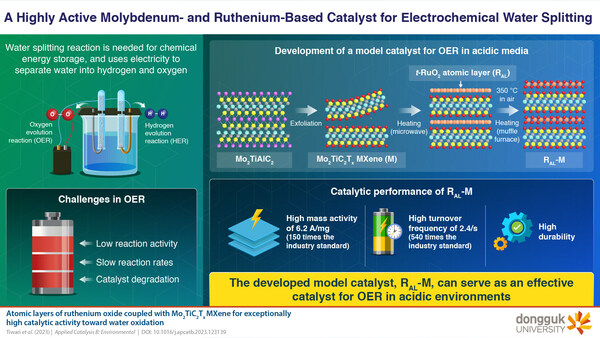
Beyond Carbon: Scientists Design A New Catalyst to Generate Green Fuel from Water
Published by Todd Bush on January 31, 2024
SEOUL, South Korea, Jan. 31, 2024 /PRNewswire/ -- Globally, the transition to greener sources of energy requires the use of efficient catalysts for fuel generation reactions. Now, scientists at Dongguk University have synthesized an efficient catalysts for the oxygen evolution reactions — a component of water-splitting process that produces hydrogen and oxygen. The catalyst, synthesized using molybdenum and ruthenium, exhibits high activity, reaction rates, and durability, opening doors to the cost-effective and large-scale production of next-generation catalysts using diverse materials.
>> In Other News: Solidec Joins Chevron Technology Ventures' Catalyst Program to Build a Carbon-Capturing Electrolyzer

Scientists Design A New Catalyst to Generate Green Fuel from Water
sChemical energy storages is a promising solution for circumventing the global energy challenges. Reduction of water to molecular hydrogen via the splitting water reaction is a key method. However, issues like low catalyst activity, slow reaction speed, and catalyst degradation pose challenges.
Now, in a recent study led by Professor Young-Kyu Han and Assistant Professor Jitendra N. Tiwari from the Department of Energy and Materials Engineering at Dongguk University, scientists have developed an effective oxygen evolution reaction catalyst with molybdenum and ruthenium. Their study was made available online on July 29, 2023, and published in Volume 339 of Applied Catalysis B: Environmental on December 15, 2023. According to Prof. Han, "Carbon materials are crucial for commercial acidic polymer electrolyte membrane water electrolyzers. At high voltages, however, carbon atoms degrade in strongly acidic media, necessitating the need for new catalyst materials beyond carbon materials."
The study involved implanting ruthenium oxide into a two-dimensional molybdenum carbide to create a catalyst (Mo2TiC2Tx MXene) with high mass activity, turnover frequency, and durability. Calculations also indicated that the ruthenium sites had a strong affinity towards oxygen species, which enhanced the reaction.
These findings are significant, as sthe global aim is to achieve 80% renewable electricity by 2050s. Hydrogen and oxygen have diverse industrial applications, spanning clean fuel, power generation, chemical production, and life-support systems. Notably, more than 90% of hydrogen is in petroleum recovery and refining (47%) and ammonia production (45%) alone.
The transportation sector will also benefit. Elaborating on this, Dr. Tiwari says, "The need for decarbonizing the transportation sector makes hydrogen a promising alternative. Going ahead, fuel cell vehicles are expected to efficiently convert hydrogen into electrical energy, emitting only water, with longer driving ranges than battery electric vehicles. Additionally, hydrogen fuel cells do not need recharging and don't degrade if hydrogen fuel is present, unlike in batteries," observes Dr. Tiwari.
This study thus serves as a guide for researchers to create new catalysts for acidic water oxidation. It also sheds light on achieving cost-effective, large-scale catalyst production using diverse materials, such as dual-transition metal catalysts.
Reference
Title of original paper: Atomic layers of ruthenium oxide coupled with Mo2TiC2Tx MXene for exceptionally high catalytic activity toward water oxidation
Journal: Applied Catalysis B: Environmental
DOI: https://doi.org/10.1016/j.apcatb.2023.123139
SOURCE Dongguk University
Subscribe to the newsletter
Daily decarbonization data and news delivered to your inbox
Follow the money flow of climate, technology, and energy investments to uncover new opportunities and jobs.
Latest issues
-
$213 Per Tonne: Inside the Latest Multi-Pathway CDR Deal
Inside This Issue 💸 $213 Per Tonne: Inside the Latest Multi-Pathway CDR Deal 🏛️ Clean Energy Technologies Affiliate Vermont Renewable Gas Advances Regulatory Review 💧 Fusion Fuel’s BrightHy Soluti...
-
The Three-Continent Move That Redefines SAF
Wishing everyone a restful holiday season.🎄🎅🎁 Inside this Issue ✈️ Cathay Goes Global With SAF in Three-Continent Fuel Deal 🧪 Proton Ventures Partners With Barents Blue For Realization Of The Bar...
-
Can One Truck Fix Hydrogen’s Biggest Problem?
Inside This Issue 🚛 Alberta's Shared Truck Model Could Crack Hydrogen Adoption ✈️ ZeroAvia Completes Financing Round 🌾 Frontier And NULIFE Scale New Biowaste Carbon Removal Approach 🔥 WAGABOX® Of ...
Company Announcements
-
Aemetis Receives Funds From the Sale of $17 Million of Federal Clean Energy Tax Credits
CUPERTINO, Calif., Dec. 30, 2025 (GLOBE NEWSWIRE) -- Aemetis, Inc. (NASDAQ: AMTX), a renewable natural gas and renewable liquid fuels company focused on lower cost and reduced emissions products, t...
-
Deployment of up to €30 million of Partner-committed capital, to be released over time in three potential tranches of €10 million each. First project expected to be a green hydrogen production...
-
Clean Energy Technologies Affiliate Vermont Renewable Gas Advances Regulatory Review
IRVINE, CA., Dec. 29, 2025 (GLOBE NEWSWIRE) -- Clean Energy Technologies, Inc. (Nasdaq: CETY) (“CETY” or the “Company”), a clean energy technology company delivering scalable solutions in power gen...
-
Production Milestone at Beaumont New Ammonia
HOUSTON -- The Beaumont New Ammonia (BNA) facility, located in southeast Texas, has produced first ammonia following the completion of systems testing, representing the first phase of operations co...